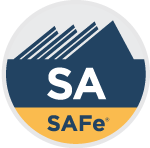“Why do we need a framework to scale agile? What does scaling agile even mean? Is it just another money-making scheme? Is it just a vehicle for Leffingwell to make a name for himself?” These were the kind of comments I started making back in 2013 when I first heard of SAFe (I even found the acronym annoying – especially that small ‘e’). I didn’t like the sound of it and didn’t trust it either. You would be right if you described me as an aggressive skeptic.
However, I acknowledged that I had limited knowledge about the framework: I’d read a few blog posts and scanned a website, but not been on any of their training. I found it tough to argue from such a position of relative ignorance? So, last week, I went on a 2-day ‘Leading SAFe 4.0‘ course with Radtac.
Am I still a skeptic? I still believe that we should try not to ‘scale’ if we can: keeping teams small and independent makes most sense to me, but I will admit that SAFe makes some good points. So what are the pros and cons and when would it / would it not make sense to use SAFe?
Pros
I like SAFe because it …
- is applied across the whole organisation and demands buy-in from the very top
- applies a revolutionary change (which may reassure people that positive change is coming)
- is a plug ’n’ play framework/model (i.e. it is defined at quite a granular level, even down to the structure of certain meetings) which many organisations will find comforting
- is flexible and modular (e.g. you don’t need to take value stream level if size doesn’t deem it necessary)
- encourages team autonomy and localised budget control
- tries to bring alignment across the globe (especially through visualisations)
- tries to connect with suppliers and bring them into the system
- caters for org-wide architecture considerations
- dedicates a regular period for innovation and planning (about two weeks each quarter)
- encourages continuous learning and personal development
- highlights the failings of an organisation (e.g. if org doesn’t have a robust, defined strategy)
Cons
I don’t like SAFe because it …
- needs wide-scale adoption
- applies a revolutionary change (so will meet resistance)
- is (overly) complicated
- uses too much jargon (although this could be good if the organisation needs revolutionary change – and brings a single voice … although I’m not sure why they had to mess with hierarchy of stories: esp. epic being top level and story being so far down)
- tries to synchronise iterations
- needs the involvement of someone who has experience in SAFe to lead an implementation (and there aren’t that many people with the relevant experience)
- needs investment (emotional and financial)
- really needs co-location / amplifies the problems encountered with distributed teams (e.g. pulling everyone together for a 2-day PI planning meeting)
- encourages long-term roadmaps, planning and estimation (e.g. a 6-12 month plan with “reasonable fidelity”!)
- requires coordination of too many people
- encourages building up team sizes (shouldn’t we be focusing on de-scaling / removing dependencies and reliance?)
When might it make sense to use SAFe?
If you’re a large corporation, working in a heavily regulated industry, which focuses on a narrow range of products, then I concede that the pros might outweigh the cons for you. But, if you are a large organisation that has sub-divisions that can be kept independent, or medium-sized, then I’d encourage working out how to keep independent over employing SAFe. If you’re a small firm, don’t go there.
Conclusion
Am I still skeptical about the need for a scaling framework? I can see that some companies might benefit from SAFe, but would still start by challenging an organisation on why they thought they needed such a framework. SAFe does make some good points and I think every team could benefit from employing some of its suggestions (e.g. re autonomy, innovation, bringing suppliers into the system), but don’t think scaling is something we should encourage.
Will I take the SAFe exam and become SAFe certified? Sure (the cost was included in the course price). Will I renew it after 12 months (at the cost of $100)? Not sure: ask me in 12 months.
What do you think about SAFe? Have you implemented it in your organisation? What do you think the pros and cons are?

Nice post David. This is certainly the most balanced view I’ve read. I’ve ways been equally sceptical about SAFe but this has made me dig a bit deeper.
Maybe unfairly, the concept of scaling Agile has never seemed particularly Agile to me. Or maybe more to the point, the Agile manifesto principles (ship more frequently, favour working software, work together with your stakeholders etc.) always seem to work regardless of scale.